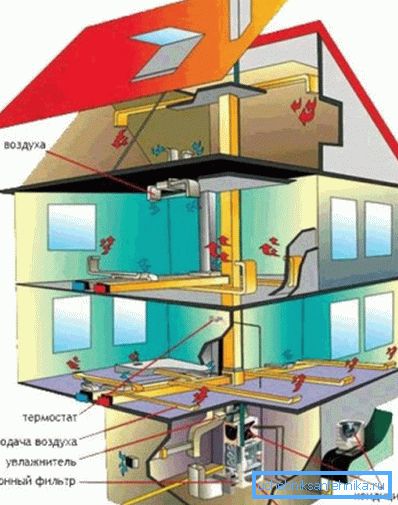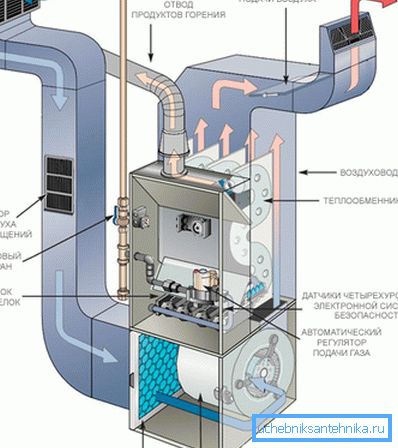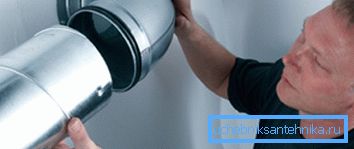Air heating and its features
In foreign countries, this type of space heating, like air heating, which is an alternative to traditional water heating, has long been popular. Recently, in our country, many homeowners began to switch to air heating, which is associated with a number of advantages of such a decision.
In this article we will take a closer look at its device and main features.

Principle of operation
The principle of air heating is based on the circulation of warm and cold streams. The heat generator heats the air masses, which penetrate into the room through the ducts, resulting in warm air displaces the cold air masses that flow through the same ducts into the heat generator.
Gas, kerosene, etc. can be used as an energy carrier for heating air masses. If heating is carried out as a result of a combustion process, the system is necessarily equipped with a chimney.
As a rule, this type of heating is used in private houses and cottages, as well as in industrial and commercial premises, sports facilities, etc. The main working element of the system is a heat generator, which often runs on electricity or gas.
The principle of operation of this device is as follows:
- The heat exchanger inside the machine is blown with air.
- In parallel with this, combustion products pass through the device, due to which air is heated to +45/65 degrees Celsius.
- Then the hot air through the ducts enters the room, where it gives off excess heat to cold air.
Heating with warm air can be implemented in two ways:
| Natural | The movement of the masses occurs due to the difference in pressure and gravitational forces. |
| Forced | Circulation of air masses is carried out with the help of electric fans. |
It should be noted that air heating is a rather complicated system of heat regulation, which implies mixing fresh air into the old one. Thus, in addition to heating, the rooms are also ventilated.
Note! It is advisable to carry out the installation of the heating air system during the construction phase of the house, as this will allow concealing ducts in the walls and ceilings.

Features of air heating
Merits
Unlike traditional water heating, heating by this method is carried out without intermediate links, such as heat conduits and radiators.
In addition, this type of heating has a number of other advantages:
- Profitability and high efficiency, as there is no intermediate coolant. As a result, even a large area heats up very quickly.
- Comfort - thanks to modern equipment and automation, air heating systems support not only the optimal temperature, but also the humidity of the air with high accuracy. In addition, filtering units provide air flow cleaning.
- The system does not interfere with the interior design., as there is no need to carry out the pipeline and install radiators.
- Security - since there is no coolant, the probability of pipeline breakthrough and flooding is excluded.
- Versatility - the system can be used not only for heating, but also for ventilation and air conditioning.
- Not complicated and quick assembly design.
- Simple instruction on the use and maintenance of equipment.
- The life of the system is up to 30 years.

Minuses
Any heating options have not only advantages, but also some disadvantages.
Air heating is not an exception in this sense, although there are very few disadvantages:
- The possibility of minor noise in heated rooms.
- The need to use filters, otherwise dust will flow into the premises with warm air.
- High cost of equipment.
- The temperature difference at the bottom and top of the room.
Thus, the disadvantages of this type of heating are not fundamental, especially considering all their advantages.

Installation Features
It is easy to equip an air heater in the house with your own hands, you just need to prepare a system plan and purchase all the necessary elements. It should be noted that the plan includes the execution of the calculation.
Incorrect calculation can lead to the failure of the heater, the emergence of drafts in the premises, as well as noise and vibration during operation of heating devices. Therefore, it is better to entrust the preparation of the project to specialists who will determine the optimum capacity of the equipment and the location of the air ducts.
As for the equipment, for the installation of the system will need the following elements:
| Heat generator | This can be a complex installation that includes fans, filters, air conditioning elements, etc. As a rule, equipment is installed in a separate room. |
| Blowers | Most often, pipes made of galvanized steel are used for these purposes. Moreover, they can be both round and rectangular or square. |
| Ventilation grates | They can be of different size and shape, are installed in places of inflow and outflow of air. These parts prevent large objects from entering the system, as well as perform a decorative function. |

Air ducts, sleeves and other elements of air heating are usually purchased in finished form. The price of all elements of the system is higher than the equipment for traditional heating, but in the process of heating this difference quickly pays off.
The assembly process itself is reduced to the installation of air ducts according to the scheme. Details are interconnected with clamps. When the installation of air ducts in the rooms will be done, the heat generator is connected to the system.
Since the equipment contains a lot of electronic devices and sensors, after installing all the structural elements, it is necessary to debug the system. This work should also be done by specialists.

Tip! Installing additional elements, such as a humidifier or a filter above the stove, will make the system more functional.
Here, perhaps, all the main features of air heating and its devices.
Conclusion
Heating the house with air is very efficient, and it also has many other advantages, which is why it has recently been considered the most promising. Its only serious drawback is the high cost of equipment, however, they quickly pay for themselves.
From the video in this article, you can learn some additional information on this topic.